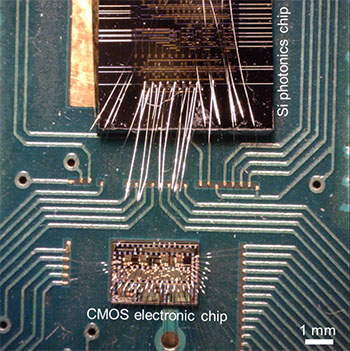
Silicon photonic chip (top) hosting microring resonator is wire-bonded to CMOS electronic chip (on bottom) containing all CLIPP readout and microring control circuitry. (Source: Grillanda et al., Optica, doi: 10.1364/OPTICA.1.000129)
The drive to squeeze thousands of photonic elements into smaller and smaller integrated circuits, and to aggregate multiple components on a single chip, is creating an ever-greater need to monitor, control, and fine-tune those circuits in real time. But how can one harvest information about the optical signal in these circuits without tapping the light itself, and thereby sapping the device’s optical power? A research team from Italy and Scotland has proposed a new approach to cracking that problem, and providing noninvasive monitoring and feedback control, for one important class of photonic device, silicon photonic microresonators (Optica, doi: 10.1364/OPTICA.1.000129).
As photonic elements move from single devices to large-scale integration on tiny chips, parasitic effects such as crosstalk, as well as functional drift due to environmental fluctuations, aging, and other insults, can become severe, especially for microresonators. Addressing the problem requires creating feedback loops that continually monitor the photonic elements and make the appropriate, real-time midcourse corrections. The techniques proposed thus far for building such controls have involved on-chip or external photodetectors that partially tap the light of the device. That works fine on single photonic devices—but quickly becomes non-scalable in large-scale integrated photonic circuits.
To build a less invasive approach, researchers from Politecnico di Milano, Italy, and the University of Strathclyde and University of Glasgow, Scotland, focused on a silicon photonic microring resonator system, and broke the problem into two parts. The first part, detection of the signal, is handled by a fully transparent light detector—using a recently developed technology dubbed ContactLess Integrated Photonic Probe (CLIPP)—that can be integrated directly inside any photonic circuit, and that can directly observe the amount of light in the resonant cavity without rerouting part of the optical power to a photodetector. The second part, readout and real-time feedback control, is handled by a separate CMOS electronic chip, wire-bonded to the photonic chip and hosted on the same circuit board.
The combined control system, according to the scientists, allows for real-time inspection of light intensity in the cavity, and control of functional drift, without affecting the resonator’s quality factor. And the team believes that the approach could be extended to a variety of complex circuits hosting many photonic components.
